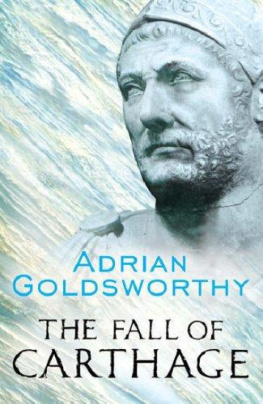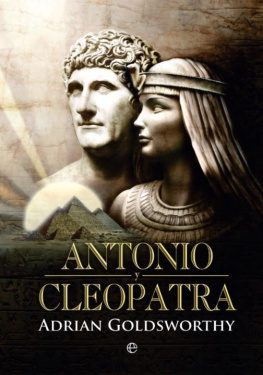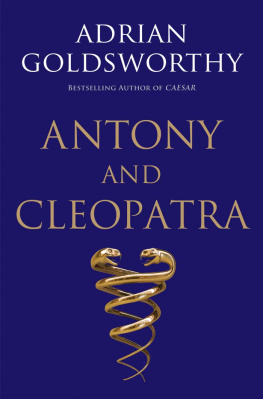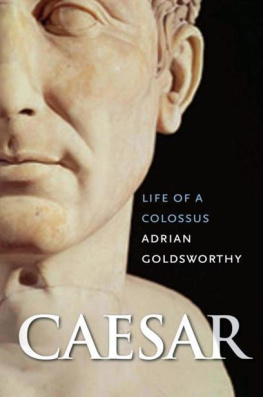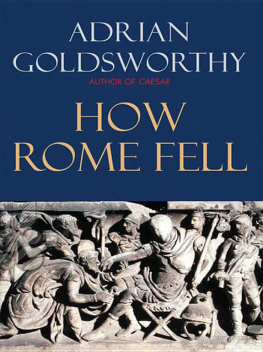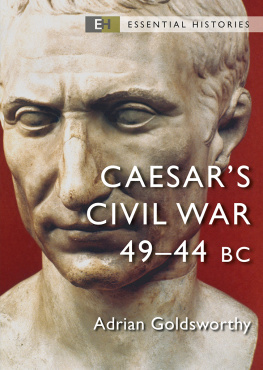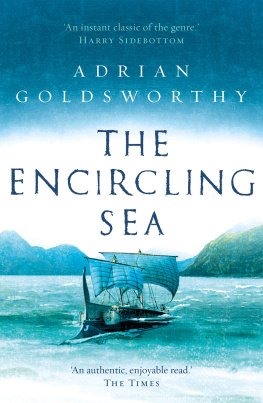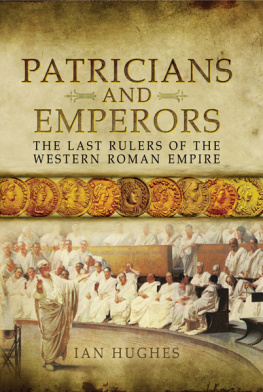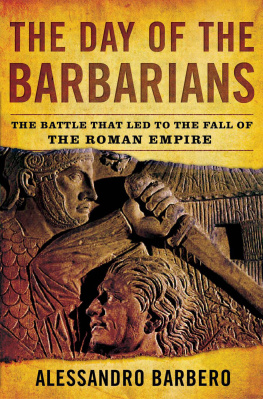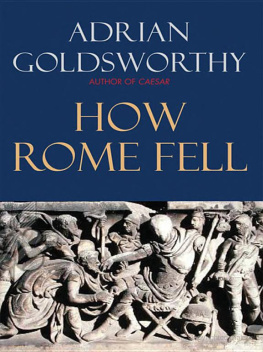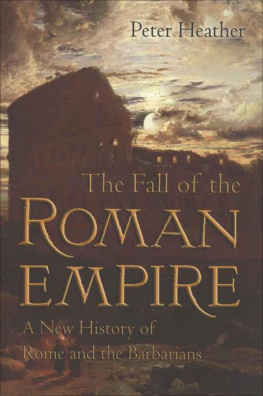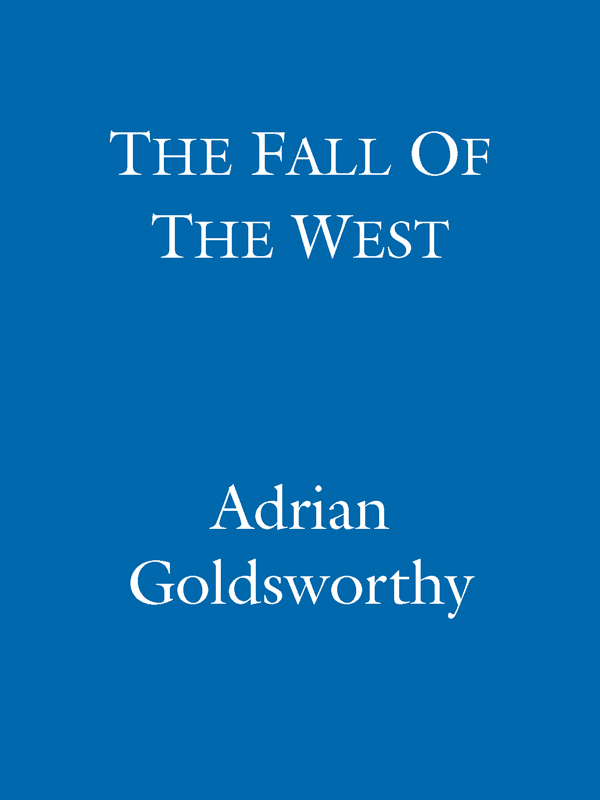Table of Contents
The Fall Of The West
ADRIAN GOLDSWORTHY
Orion
www.orionbooks.co.uk
Preface
If people today know anything about the Roman Empire, it is that it fell. This is without doubt the best-known fact about Ancient Rome, just as Julius Caesar is the most famous Roman. Romes fall is memorable because its empire lasted for so long - more than five hundred years after Caesars death in Italy and the western provinces, and three times as long in the east, where emperors would rule from Constantinople until the fifteenth century. The Roman Empire was also exceptionally large - no other power has ever controlled all the lands around the Mediterranean - and left traces behind in many countries. Even today its monuments are spectacular - the Colosseum and Pantheon in Rome itself, as well as theatres, aqueducts, villas and roads dotted throughout the provinces. No other state would construct such a massive network of all-weather roads until the nineteenth century, and in many countries such systems would not be built until the twentieth century. The Roman Empire is often seen as very modern and highly sophisticated - glass in windows, central heating, bath houses and the like - especially by visitors to museums and monuments. This makes Romes fall all the more remarkable, especially since the world that emerged from its ruin appears so primitive by contrast. The Dark Ages remain fixed in the popular mind, even if the term has long since been abandoned by scholars.
Why Rome fell remains one of the great questions of history. In the English-speaking world fall is inevitably coupled with decline, for the title of Edward Gibbons monumental work has become firmly embedded in the wider consciousness. No other eighteenth-century history book has remained so regularly in print in various forms and editions until the present day. There have been plenty of other books written on the subject, and some have been more perceptive in their analysis, even if none has ever challenged The Decline and Fall of the Roman Empire as one of the great works of English literature. In later life Gibbon liked to believe that it was his destiny to be an historian and to chronicle the great theme of Romes fall. He claimed a specific moment of inspiration: It was at Rome, on the fifteenth of October, 1764, as I sat musing amidst the ruins of the Capitol, while the barefooted fryars were singing Vespers in the temple of Jupiter, that the idea of writing the decline and fall of the City first started to my mind.
Gibbon produced several versions of this story, creating the suspicion that he embellished or even invented the memory. On the other hand it is hard for any visitor with imagination not to think similar thoughts, for past and present seem very close beside the centre of Ancient Rome. The barefooted fryars are no longer so obvious, and have been replaced by the ubiquitous hawkers, switching instantly from offering sunglasses to umbrellas whenever the weather changes. Even the crowds of other tourists tramping along the Sacra Via help to give a sense of the bustle and noise of the ancient city, once every bit as busy and active as the modern city that now surrounds it.
Rome is not only a museum, but also a vibrant community, the capital of a modern country and the centre of the worldwide Catholic Church. The reminders of ancient grandeur sit side by side with homes, offices and restaurants. Rome was never abandoned, although it shrank massively in population from the height of the empire in the centuries after its fall. A good number of other modern cities are also built on Roman foundations, something still visible in their grid-shaped street plans. Other Roman cities vanished altogether and those in desert areas produce some of the most romantic ruins visible today. When the Roman Empire fell, life did not simply stop in the lands it had controlled. The context of life certainly changed, sometimes dramatically and quickly, but in other cases much more gradually. As the specialists on the period have long since made clear, the Dark Ages were not wholly dark, although by any reasonable standard they were dark enough in comparison with the Roman period. Many things became more local, such as power and trade, and often the world was a more dangerous place, with raiding and warfare between nearby communities now a real possibility. Quite quickly there was no one with the money or skill to build great monuments such as theatres, aqueducts or roads. In time, it even became difficult to maintain the ones that already existed. Scholars are deeply divided about when, how and why the world changed from the Roman era to the basis of the medieval world that took shape in the following centuries. None doubt that the change occurred.
Gibbon admired the achievements of the Roman Empire at its height, as did all educated Europeans in his day. This in no way reduced his enthusiasm for the modern world, and especially for the constitution of his own country, where the monarchs power was limited and guided by the aristocracy. Gibbon knew that his own country and its neighbours across the Channel all owed their origins to the various barbarian groups that had carved up the Roman Empire. Therefore, in time, good had come from chaos and destruction, and from his perspective the world - or at least the Western world - had in the long run developed along the right lines. This mixed attitude to Romes fall remains a central part of its fascination. It serves as a warning of mortality. The emperors who built the great arches in the Forum all died like any other human being. Eventually their empire - so rich, so powerful, so sophisticated and so utterly self-confident - also came to an end, its monuments crumbling away into ruin.
The imagery of Ancient Rome has frequently been invoked by more recent states for its associations with the ultimate heights both of power and civilisation. It is never long before talk also turns to Romes fate. Insiders to the modern great power usually see this as a humbling reminder that everything passes, and perhaps as a warning against complacency and corruption. Outsiders, and especially those resentful of the power of others, tend to prefer the thin comfort of the belief that the current power will eventually fall. Many states have been compared to the Roman Empire. A century ago the most natural comparison would have been with Britain, and then perhaps with France or one of the other great empires of the age. Nowadays, it is inevitably with the United States of America.
The form varies, as does the tone. In recent years the best-selling novelist Robert Harris has written about Roman themes, openly declaring that this was a way of commenting on modern America. The BBC also screened a television series hosted by the former Python Terry Jones called Barbarians, with the theme that the reputations of other nations had been blackened by Roman propaganda. It was highly entertaining stuff, even if the message was somewhat strained - the Greeks would certainly have been most surprised to be considered barbarians, since they were the ones who first coined the term for the rest of the world. In interviews at the time, Jones made clear that the series was drawing a direct parallel with the American superpower, and openly criticised the war in Iraq. For many, criticising Rome has become a way of criticising American policy and culture. Inevitably, this affects their view of both.
Milder and less detailed criticism is even more common. At certain sorts of parties, the discovery that I am an ancient historian almost inevitably prompts someone to remark that America is the new Rome. More often than not this is followed by a smug, of course, they dont see it. This at least is utterly false, for Americans have been comparing their country to Rome since its foundation. In shaping the new country, the Founding Fathers consciously hoped to copy the strengths of the Roman Republic and avoid its eventual downfall. These days, it is also fair to say that the different university systems tend to make educated Americans broader in the range of their knowledge than the British. Plenty of engineers or medical doctors in America will at some point have taken a course or two in history or even the classics, something which is unimaginable on this side of the Atlantic. This is one of the reasons why Roman analogies remain exceptionally common in the USA, and are routinely made by politicians themselves as well as journalists, political commentators and the wider public. Usually it begins with the assumption that the USA as the sole superpower left in the world is dominant in a way unmatched by anyone since the height of Roman power.


